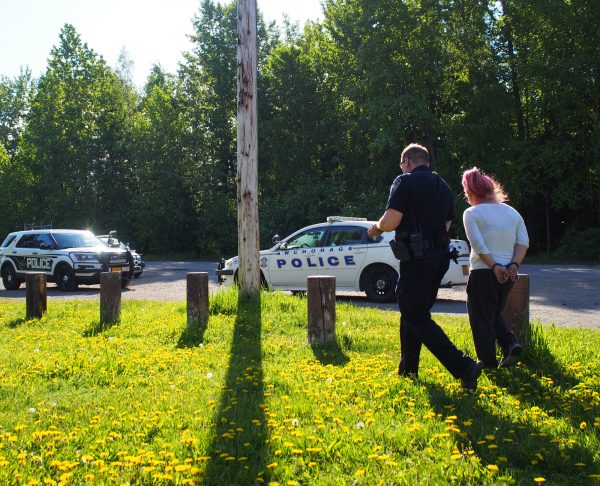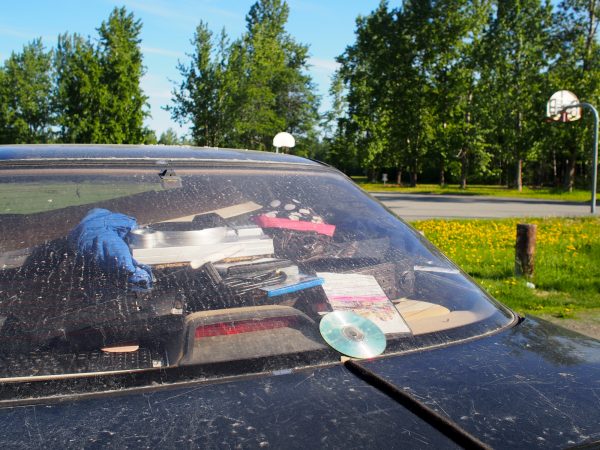
Police in Anchorage are trying something new: having officers patrol beats built around community boundaries, rather than covering the entire city. It’s an attempt to deliver “community policing,” a general set of tactics the mayor’s administration has emphasized as it continues increasing the size of the police force.
On a recent weekday morning, Officer Brian Fuchs was patrolling his beat in the Mountain View neighborhood. He got out at a popular park and began checking on people sleeping in their vehicles to make sure they weren’t in distress.
Then, he wandered down a footpath into the woods, where there were half-a-dozen tents and piles of rubbish. Hidden under branches and a tent cover was a small Mazda spray-painted black. In the backseat, two people were asleep.
“Hey, open the door,” Fuchs said, knocking on the window and growing increasingly alarmed.
“Is she alive?” he asked a bleary-eyed young man. Fuchs couldn’t see her breathing, and when the boyfriend tried shaking her she hardly stirred.
“Ma’am, are you ok?” Fuchs asked, reaching into the car.
The 19-year-old woman gradually began to come around. She exited the car but had trouble standing. Fuchs asked the 20-year-old boyfriend if they’d been using drugs. He said no, but the backseat was littered with used syringes. Worried the woman might have overdosed, Fuchs called for an ambulance to check her out. There were no drugs on hand, and the car’s ownership status was unclear. Short of having medics evaluate the young woman, there was not much for police to do.
“These kids are out here, addicted to drugs, living on the streets,” Fuchs said. “It’s just a sad state of affairs for these kids, wish I could do more for them.”

This interaction didn’t happen in response to a specific call for service. Essentially, it was a spontaneous intervention in the course of an officer patrolling his community beat. And it’s the kind of policing that the Anchorage Police Department and Berkowitz Administration want more of.
For the last few months, APD has been sending officers to the same parts of town each shift, making them responsible for safety in one area rather than the city as a whole.
“It does give you a greater sense of ownership to the one area where you work,” said Fuchs, who has been with the department for more than a decade and lives outside of the municipality.
In the past, officers moved around the city during their shifts. One minute they might be responding to a call in South Anchorage, downtown the next, and the east side after that. A lot of this was simply triage, with available units racing between the most serious incidents while deferring less time sensitive requests for help.
The department’s staffing levels fell low enough that it became a central campaign issue in the 2015 mayor’s race.
According to Fuchs, the situation left officers frequently scrambling to react. And the public never knew who would show up to a call.
“If the officers are constantly changing in an area, that can cause contention for some people if they don’t know who they’re going to get,” Fuchs said during the course of a ride-along that lasted the majority of his morning-to-afternoon shift.
It’s not as if under the new strategy Fuchs is confined to Mountain View. He still responds to calls in other areas. At one point in the morning there was a request for backup, and Fuchs turned his sirens on as he sped through traffic to get downtown.
Mostly, though, he spent this particular weekday responding to lower level calls, like de-escalating a tenant-landlord dispute, transporting a woman to jail and investigating a tripped alarm inside an industrial park.
He also spent a lot of time simply rolling through Mountain View’s side-streets, waving at people, listening to scanner messages and looking to see if anything appears suspicious. Like a pile of discarded junk next to two burned out abandoned buildings. As Fuchs examined a mound of old couches, a broken TV and a bucket of spent bullet casings, a woman wandered over to him.
“Hi ma’am, how are you?” Fuchs said cheerily. “I’m Brian.”
They began commiserating about how all the garbage had appeared in just the last week or two. And Fuchs had credibility in the conversation, because he had been by frequently enough understand where the woman was coming from, how the site had already been once cleared. He shared her frustration. He told her who at the city to call, and the phone number she could reach him at if she needed.
Interactions like these are what the city means when it says it wants more community policing. However, it’s hard to measure the effectiveness of this approach in reducing crime. The new patrol model started in March. Assembly members and the heads of several community councils say that to the extent residents are noticing the changes, they are pleased.
“We’ve seen more cops,” said Mark Butler, who lives in the North Star Community Council’s area. “They seem to be interacting with the public a lot more.”
“It’s totally great,” said Patty Higgins of the Abbott Loop Council, adding that anecdotally people she has spoken with feel somewhat safer.
Allen Kemplen with the Fairview Community Council has not yet seen a difference from the new policing strategy, but says that the neighborhood generally has a cooperative relationship with APD. Still, he believes the community boundary policy’s efficacy is constrained by other limitations in the criminal justice system.
“I don’t see the connection with the prosecutor’s office,” Kemplen said as an example. The point he and others have made is that proactive policing has limits in an environment that lacks access to substance abuse treatment, sufficient housing for the homeless, and a severely strained legal system.
What everyone does seem to agree on, though, is that this type of policing is only possible because APD has grown its ranks, putting enough officers on the street that they aren’t constantly in a state of reaction. Which, according to Fuchs, is crucial.
“If you’re constantly going call to call to call to call to call, which we do a lot of, then you never have the opportunity to do community-based policing, and going out and talking to people and doing all these different things,” Fuchs said.
Currently, APD is staffed at 406 officers, significantly higher than in recent years, but still about 40 positions short of what is recommended for Anchorage based on a comprehensive report issued by the Police Executive Research Forum.
Zachariah Hughes reports on city & state politics, arts & culture, drugs, and military affairs in Anchorage and South Central Alaska.
@ZachHughesAK About Zachariah




